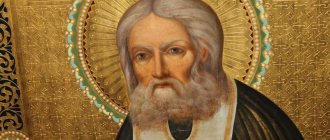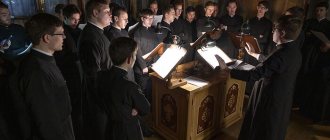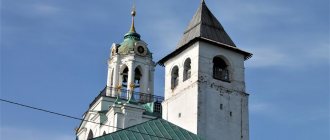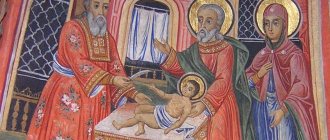Not all Orthodox believers find it easy to navigate a world filled with a special holy meaning. Many questions arise from believers, to whom they turn for help, one of them concerns how to correctly read the Mother of God rule, and what it is. The Mother of God is revered by the Orthodox on a par with Jesus Christ, which is why prayers addressed to her are always miraculous and powerful.
What is the Mother of God rule?
In the Orthodox world there are many rules, or prayers that are mandatory to know and read regularly. The Mother of God daily rule for all believers is one of these important rites. This is a series of prayers that describe the main eras of the life of the Virgin Mary. Every Orthodox person should pray not only to the Lord, but also to the Mother of God. She is considered the great intercessor of all humanity. There are several options for reading the rule; the power of the Mother of God rule will not decrease depending on which option you choose. The main thing is to do this with heartfelt faith in the Lord and the Mother of God.
History of the Mother of God Rule
The prayers in the Theotokos rule are divided into fifteen parts or tens, just like the life of the Blessed Virgin Mary. According to legend, the Virgin Mary in the eighth century ordered several saints to constantly recite a certain prayer in order to feel her love and learn to accept it. This rule is not widespread, but is considered a deep and effective prayer. The complete Theotokos rule mentions in every ten a specific stage of the life of the Mother of God:
- Birth of the Mother of God, prayer for all children.
- Presentation of the Virgin Mary into the temple, prayer for those lost who have fallen away from God.
- Annunciation of the Mother of God, prayer for help to those who mourn.
- Acquaintance of the Virgin Mary with Elizabeth, prayer for the meeting of the separated.
- Nativity of Christ, prayer for new life with love for Jesus.
- The Presentation of the Lord, prayer for help on the day of death.
- Flight to Egypt, prayer for help in the fight against temptations.
- The disappearance of Jesus in Jerusalem, a prayer for finding Christ in the heart.
- Miracle in Cana of Galilee, prayer for those in need.
- Standing of the Mother of God at the cross, prayer for deliverance from despondency.
- Resurrection of Christ, prayer for the resurrection of sinful souls.
- Ascension of the Lord, prayer for the ascension of the soul from worldly worries.
- Zion Upper Room, prayer to the apostles.
- Dormition of the Virgin Mary, prayer for a peaceful death.
- The Mother of God is glorified, a prayer for the protection of people from all evil.
Mother of God in the church hierarchy
For believers, the highest position of the Mother of God in the religious hierarchy is obvious. She comes second to God, above the angels and saints. According to Orthodox teaching, God is represented in 3 persons:
- Father;
- Son;
- Holy Spirit.
The Virgin Mary became the mother of Jesus Christ after God's grace descended on her and the immaculate conception occurred. After 9 months, Christ appeared, combining the features of God and man.
The Mother of God was always with him, sharing his hardships and hardships, and saw the suffering of Christ on the cross, death and resurrection. All this made it possible for her to understand the needs of people and help them.
After the death of the Mother of God, her veneration began, many icons streamed myrrh, today there are about 800 icons, in front of which believers pray and receive what they ask for, miraculous help is expressed in numerous healings. The number of texts containing appeals to the Most Pure Mother of God is large.
Why is the Mother of God rule read?
Believers understand why the Mother of God rule should be read. This is a really powerful prayer that helps a person. In any circumstances - serious illnesses, sincere sorrows, deep sorrow, worries about loved ones, sinful thoughts - you need to turn to the Mother of God rule, miracles will not keep you waiting. If you approach prayer correctly, consciously pronounce the Mother of God rule, the fires of unnecessary passions in the soul will go out, you can rise from the depths of sin, get a chance for salvation, and feel the protection of the Most Holy Theotokos over you.
Hymn of the Theotokos at the service
The Theotokos can be heard during divine services; this is a special chant dedicated to the Most Holy Theotokos. It can be performed in 3 different ways:
- stichera - a text reminiscent of a hymn, pronounced along with psalms from the book of Psalms;
- troparion - a short chant that reflects the essence of the church holiday;
- sedalen - when the chant is being performed, it is allowed to sit.
The Theotokos are usually used at the end of a stichera, troparion or sedalena. You can read this text in all liturgical publications, except the Gospel. You can hear the Theotokos at any service.
There is also a division into 4 groups when they are proclaimed:
- on Sunday and on holidays - after stichera;
- on Sunday, as well as on holidays after the troparions of dismissal;
- on weekdays - after stichera;
- on weekdays - after the troparions of dismissal.
Usually they are at the end of the verse Glory to the Father and the Son and the Holy Spirit Amen, Theotokos are divided according to voices, their location is at the end of the liturgical books (appendix).
An important group is the Theotokos dogmatists, there are 8 of them according to the number of voices, they set forth in a concise form the dogmas - immutable establishments concerning the Most Holy Theotokos.
Their presence means the exaltation of the role of the Blessed Virgin in the salvation of humanity; she is able to beg Christ to have mercy on sinners. The main idea is that Christ became incarnate from the virgin Mary through the grace of the Holy Spirit.
At the services of the Theotokos, the dogmatists sound very beautiful; their place in the service is after the stichera on the Lord, the invocation during Sunday Vespers.
Another variety is the Holy Cross, which reveals the full depth of the suffering of the Mother of God, when the Lord was on the cross, she let everything pass through her heart. Time and place of prayers:
- Vespers on Tuesday, Thursday;
- Matins on Wednesday, Friday.
At these services, the Cross of the Lord is venerated, its greatness and the grief of the Mother of God are sung.
How to read the Mother of God rule correctly?
Many do not know that the Mother of God rule should be read 150 times, no more and no less. It is believed that the Virgin Mary herself named this number. After every ten prayers, you must also read the well-known lines of “Our Father” and “The Doors of Mercy.” It is believed that in the Theotokos rule the Lord is remembered, and by reading the prayer correctly, you can touch not only the Mother of God, but also Jesus Christ himself, receiving a blessing from both the Virgin Mary and her son.
Secrets of reading the Mother of God rule
Reading the Mother of God rule is not as easy as it might seem at first glance. Believers always use blessed rosaries to change the bead after reading every ten prayers. First you should try to read the prayer 50 times. Over time, you need to try to reach the described order of reading the Mother of God rule by Seraphim of Sarov - 150 times. Every word in prayer should be read consciously and thoughtfully. Otherwise, such a prayer cannot be counted, and the bead on the rosary comes back.
What does the “Unbreakable Wall” icon look like? Image, description, meaning. What does it help with? Photo
The holy face is painted in a special, recognizable style of icon painting. Image type – Oranta. The faces of the Blessed Virgin, created in this style, were called the “Unbreakable Wall”. It was borrowed from the Akathist to the Mother of God. Quote: “Rejoice, indestructible wall of the Kingdom.” For a long time, the icon was called so due to its meaning - strong protection and help, which is provided thanks to the participation of the Holy Virgin.
The face on the icon of the Mother of God “The Unbreakable Wall” is depicted with raised hands. The Mother of God is shown in full height. The original is in the St. Sophia Cathedral in Kyiv - under the arch of the high place. Other elements of the image: an inscription made in black, which translated means: “God is in her midst and does not move: God will help her in the morning.” In addition, the Holy Face of the Mother of God is shown on a rectangular golden stone. The semi-arch is also made in a golden tone. On some lists, the Virgin is depicted differently - on a cloud. The pose and message remain unchanged.
It is believed that the name of the icon was given due to its stability and strength. It is unshakable - located on that part of the wall that has been preserved for 800 years without signs of destruction. The indestructible face of the saint is resistant to any deformation of the supporting structure. This is a testimony to the power and might of God. By comparison, the rest of the cathedral in which the image is located has undergone changes more than once.
The history of the appearance of the Holy Face with raised hands
associated with the monk from the Spaso-Eliazar Hermitage and his vision.
So, according to legend, the Mother of God appeared to him in a dream. The monk saw a beautiful city, which could be reached by two roads. It was possible to walk along one (wide and free) faster, but there a terrible monster caught in a net everyone who tried to pass.
It is more difficult to walk along the second road (a narrow one running over a cliff under a high wall), but here the monster could not destroy those walking - the network was short, and the wall protected. As a result, the monk, in his dreams, unhindered the impassable path along the second of the roads.
He found himself in a beautiful city,
Here I saw the Lady.
The image of the Mother of God has been protecting people and helping them for 9 centuries. In 2011, a convent was created in honor of the Holy Face of the “Unbreakable Wall”. The main function of the icon is to protect the person praying and save him in different situations. You can make requests:
- about protection from external enemies of the state, war, secret opponents and obvious ill-wishers;
- protection of the home when the owners are not present;
- about visiting the house only by people who do not have malicious intent;
- protection from robbers.
There are several lists of the original icon. You can hang an image of the Holy Face in your home or read the sacred words in front of a candle over a small image. There are many known cases of healing in this case. Praying before the Holy Face of the Mother of God helps restore the spiritual connection with God. You can refer to the lists that are located in several Moscow churches, as well as in Kaliningrad.
The main meaning of the icon is
providing the opportunity to rely on the indestructible and irresistible image of the Mother of God, and through her - on the Lord God.
When deciphering the name of the icon of the Most Holy Theotokos “The Unbreakable Wall,” one can hear the call to give to the Almighty as much as a person receives from him. It is about faith and love for the Heavenly Father. The stronger these feelings, the greater the Lord's protection. In addition, the power of the Holy Face is resorted to in other cases:
- You can pray for the health of children and adults;
- about conception, the appearance of children;
- the advent of peace between relatives;
- about marriage;
- about protection from troubles and the greatest difficulties;
- about healing the body in case of developing diseases and injuries.
Prayer - the Mother of God rule
The Holy Fathers describe their state during the pronunciation of prayer: every now and then fatigue sets in, yawning begins, the temperature rises, extraneous thoughts creep into the head - these are demons that distract from the pronunciation of the prayer. Reading the Mother of God rule is difficult; only a serious attitude and detachment from everything superfluous can help you master the text and its meaning. To avoid distractions, you should retire to the room, concentrate, and get ready for serious work. The Mother of God rule can be read while sitting, feeling each word read as a firmly driven nail.
We praise both the Son and the Mother
This version of the Theotokos Rule is difficult to remember, much less memorize. Therefore, without a book with the text of the petitions, you cannot read it. And there may not be a source at hand. Therefore, there is another way to read the rule.
- Repeat “Rejoice, Virgin Mary” ten times. Then read the “Our Father.”
- Repeat the prayer of the Mother of God 10 times again, and again say “Our Father.”
- And so on.
There may be other variations in the reading of the Theotokos Rule. An acceptable way to create this prayer can be suggested by your confessor.
The Holy Fathers emphasized the importance of the Theotokos Rule. There are no petitions to the Mother of God, and there is no mention of Jesus Christ. But those who read the prayer can be likened to angels. They sing the praises of the Mother of God all the time. And by pronouncing the words “Lord”, “Savior”, “fruit”, the believer praises the Son of God. And together with Him His Most Pure Mother is glorified. Thus, believers enter into prayerful communication with them and are under their heavenly protection.
Text of the prayer rule
Although the prayer itself consists of two dozen words, there are several options for addressing the Mother of God. There is a full and abbreviated version of the rule. Both include the daily reading of the prayer 150 times and additional appeals after every ten.
The full text is intended for experienced prayer books and contains troparia, stichera from the service, and a concluding prayer. If you are praying for healing from a serious illness, constant troubles in the family, or the return of a missing family member, it is better to choose the full option, asking for a blessing from the priest.
Abridged version
For beginners, it is recommended to start by reading the Song 50 times daily. Gradually increase the number of repetitions up to 150 times.
After every tenth prayer read:
- “Our Father, who art in heaven! Hallowed be Thy name, Thy kingdom come, Thy will be done, as it is in heaven and on earth. Give us this day our daily bread; and forgive us our debts, as we forgive our debtors; and lead us not into temptation, but deliver us from the evil one. For Yours is the kingdom and the power and the glory forever. Amen"
- “Open the doors of mercy to us, Blessed Mother of God, who hope in You, so that we may not perish, but may we be delivered from troubles by You, for You are the salvation of the Christian race. Rejoice, One Most Pure Mother of the One Creator, Lord, God and Savior of ours, Jesus Christ! Be my Intercessor on the day of the terrible trial, when I appear before the Throne of the Unfeigned Judge, so that I may be delivered from the fiery punishment of torment through Your prayers, O Blessed One. Most Holy Theotokos, save us! »
Night prayer on the Kanavka of the Most Holy Theotokos
There is another type of prayer - night prayer. It is connected with the legend that it is at 3 o’clock in the morning that the Most Holy Theotokos herself visits Diveevo and walks along her Kanavka.
It is not surprising that many believers, including pilgrims, having learned about this, strive to walk along the Kanavka with prayer at night. Someone seeing the kilometer-long monastery fences, inside of which the Kanavka is also included, and remembering that the monastery is closed at night, will be surprised. Yes, indeed, the monastery’s opening hours are limited - from 5 a.m. to 11 p.m. at night, after which all the gates are closed. But! Everyone in the monastery knows about this legend, and there is a blessing to let people into the Kanavka even at night.
Once you say your cherished word to the guard at the gate that you want to pray on Kanavka at night, they will let you through. But only there! So don’t tempt fate and try to get somewhere else in the dark. Monastics also need rest, like all other people.
At night on Kanavka they also read the Mother of God rule. Or they simply pray in their own words.








